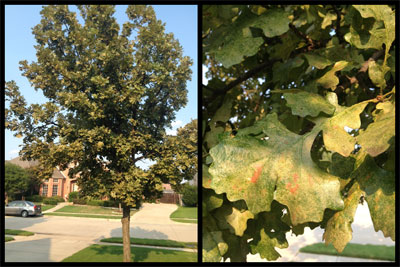Question and Answer — September 2013
(Special note from Neil) This is one of the most-viewed parts of e-gardens each edition. Thanks for sending your photos and questions. I answer as many as I can. We promise six to eight, but I normally try to under-promise and over-deliver. One thing I can’t change, however, is the need for a photo with your question. The formatting of this column requires one or two photos, and the column’s value is heightened by your including one. It’s easier if it’s a fairly small file size, but that’s not critical. But the photo itself IS critical. It also helps a big bunch if you’ll tell me your city. How I answer a question from Brownsville will certainly be different from how I address one from Amarillo. Finally, I normally don’t do plant IDs here unless they are critical to a question of much greater general interest. We get dozens of “Neil, is this a weed?” types of questions, and the column would look rather odd if they were included. Normally they are of concern only to the person sending the photo. So, with that longer-than-normal explanation, click to send us your photo and question. Here are this month’s answers.
Question: This aggressive vine is trying to take over my flowerbed. I pulled it up in June, and it’s already back. What can I do to eliminate it? B.D., no city given
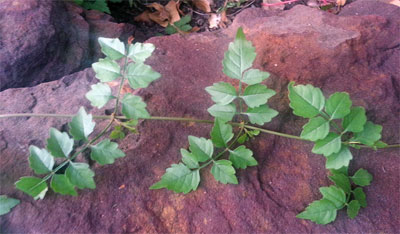
Answer: Peppervine (Ampelopsis arborea) is a common vine in much of Texas. While it’s attractive on fences, it does indeed invade. I’d try hand-digging, as you have done. Next spring, when the new growth is strong and tender, use a foam rubber paintbrush to apply a broadleafed weedkiller (containing 2,4-D) specifically onto the weed leaves. You may have to treat several times, probably a month or so apart.
Question: What is wrong with my poor oak tree? Others nearby look fine, but mine is so sad. L.W., no city given.
Answer: This is lace bug damage on your bur oak, and the good news is that it’s completely temporary. The insects may or may not return next year. In fact, you may even see new, clean-and-green growth this fall. The best way of coping with this would be to apply a systemic insecticide such as Imidacloprid in early June. It goes in through the roots and will protect the tree from showing this issue.
Question: I have numerous brown patches in my bermuda despite regular watering. I fertilized with 13-13-13 earlier this spring. Our soil is rocky and shallow, as we are on a ridge. Do we need to add fortified soil to those areas? J.W., Aledo.
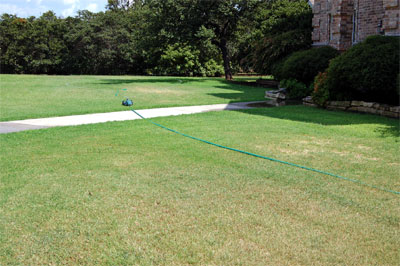
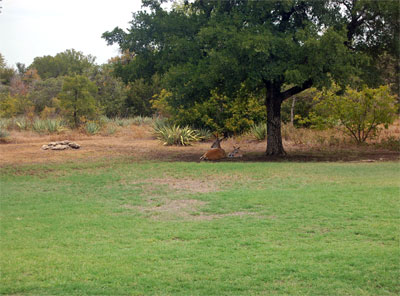
Answer: I was on two lawns in DFW 10 days ago, and each looked just about like yours does. A plant pathologist was with me, and his cultures did show some evidence of Take All Root Rot on bermuda. However, the soil core borings also showed almost no reservoir of decent soil to capture and hold the moisture and nutrients. The comparison we both drew was that this was like someone who’s had stomach surgery. The lawns would benefit from more frequent waterings (assuming curtailments allow), but not necessarily as much water applied at one time. Also, more frequent and lighter feedings, since the soil is incapable of capturing nutrients. Your lawn probably needs only nitrogen. The big push in the past 10 or 20 years has been to get us away from using phosphorus (middle number of the fertilizer analysis). The pathologist also suggested to those two homeowners that they try to break the surface tension on the poor soil so that water could penetrate more efficiently. His suggestion was either to buy a commercial surfactant, or to apply a liquid dishwashing detergent (blue Dawn) with a sprinkling can or siphoning proportioner). Finally, he suggested that they apply a 1-inch layer of sphagnum peat to help address the TARR. I believe that they are trying all of those in a test, but not all on the same patch of turf. They want to see which makes the greatest difference. I won’t know for several more weeks.
Question: This white fungus is very powdery, but it also contains an insect. I found it on my hibiscus and Rose of Sharon. What is it, and how do I control it? B.E., Austin area.
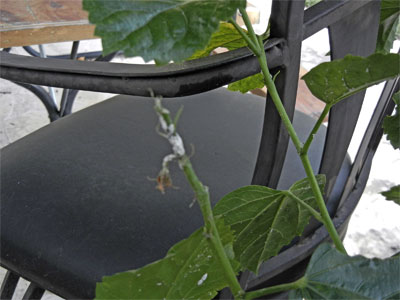
Answer: This is cottony leafhopper, and the insect you saw has created all this camouflage around itself. It’s not a huge concern, other than the mess it makes, so you might first try simply to blast it off with a stout stream of water from the garden hose. General-purpose insecticides, especially systemic ones, will help a great deal if you see it starting again another year. Look for warnings of possible damage to hibiscus, however. Their foliage can be a bit sensitive.
Question: I have a slope in our front yard that is covered with trailing vinca groundcover. Every July/August it gets this disease and dies. Then it comes back in the fall. Should I replace it with something healthier? M.S., no city given.
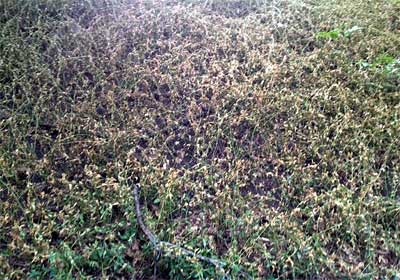
Answer: Trailing vinca groundcover is smacked with vinca leafrollers (insects) mid-summer each year. Nothing is prettier than this groundcover in April, and nothing looks any worse than it does by late summer. You might give it one more year, and try protecting it with a systemic insecticide (Imidacloprid) applied as a soil drench in early to mid-June. The insecticide goes in through the roots and should stop the pest as it tries to feed. Honestly, I’ve not seen anyone try this technique on vinca, because there isn’t that much of that groundcover used any more. I’ve had great success with both purple wintercreeper euonymus and Asian jasmine in both sun and shade in my landscape. Since I don’t know where you live, I don’t know if Asian jasmine would be winter-hardy for you. Talk to your nurseryman. Spring would be the best time for the change.
Question: I have an angel wing begonia that was given to me by my husband’s mother many years ago. I’ve started several over the years, but now I’m down to just one, and it has a leaf disease that causes browning around the edges and at the tips of the leaves. It gets strong light, but no direct sunlight in the entry to our house (southwest side). I have a different variety elsewhere, and it’s doing fine. How can I stop this? R.C., McKinney.
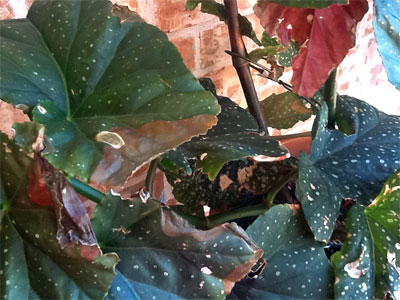
Answer: This really doesn’t look like any type of disease. Anytime you see marginal or tip leaf burn, that points to moisture stress. It can be caused by many things, including a plant that has gotten too dry, too much wind, a little too much sun, accumulated mineral salt in the soil, over-feeding, heat, worn-out potting soil – and on and on. I lost my mom 22 years ago, and I’ve been nurturing her angel wing begonia (also in McKinney) all of that time. Mine looks just about the same as it originally did, and I’m going to repot it into fresh, quality potting soil in a month or so, after the weather breaks.
Question: I have three patches of what I have been assuming to be TARR. I’ve been treating with peat moss. Is it common for TARR to come back in the same spots each year? L.P., Anna.
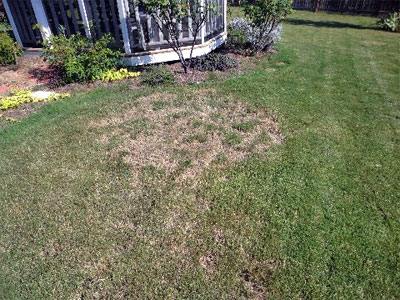
Answer: TARR in St. Augustine almost always shows up in April and early May, and it won’t be in patches as distinct as this. This is almost assuredly chinch bug damage. Here is what I have in the Most Asked Questions section of my website. You might also scroll through the other St. Augustine problems and their solutions for future reference. http://www.neilsperry.com/maq/lawns/my-st-augustine-is-yellowing-and-looking-dry-along-my-sidewalk.html
Question: What would have caused my Bradford pear to have gone from vibrant green to this in just a week? M.D., East Arlington.
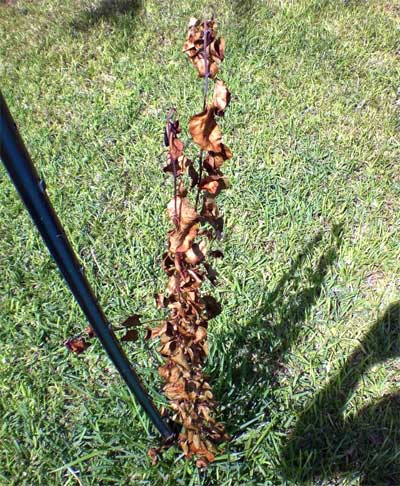
Answer: This is an unusual tree because it’s so small. My first blush, before I saw the photo, was that it was going to be the soil-borne fungus cotton root rot on a mature ornamental pear. And it could still be that, although CRR normally doesn’t attack plants that are this young. The disease also is found only in alkaline soils, and East Arlington, at least the parts I’ve been in, is in the band of red, sandy acidic soils (as per near The Ballpark, since your e-mail said “Go Rangers”). So, CRR isn’t the only possibility. The other thing that could have happened would be that the tree just got too dry. As small as it is, it can’t have much of a root system. In either event, I doubt if it will come back. Fact is, you’re probably better off planting another species of shade tree, since Bradford pears normally are gone within 12 or 15 years anyway. I’d talk to your nurseryman about the best type for your needs.
Question: I have moved two crape myrtles that were planted here because they were a variety that grows to 25 feet tall. I replaced them with Brite-n-Tite cherry laurels because I was told that they only grow to 10 to 12 feet (perfect). I’ve more recently read that they can grow much taller – to 20 or 25 feet. What do you think? S., Frisco.

Answer: Regular cherry laurels will grow to 20 or 25 feet tall and wide. They’re actually sister plants to peaches and plums. However, Brite-n-Tite stays in the size range you were expecting. (And that should end my answer, but no, not Neil. It’s on to answer unasked questions.) Cherry laurels, including this cultivar, struggle with the highly alkaline Blackland Prairie clay soils. They typically run aground with iron deficiency after 5 or 8 years, which is why you so seldom see them in local (DFW) landscapes 10 years after they’re planted. Honestly, I hate to see them being sold where soils are alkaline because they’re ticking time bombs. If you ever need to replace them, I have used Oakland and Oakleaf (very similar) hollies in settings exactly like yours for the past 12 or 15 years, and I’ve been thrilled with the results.
Question: I bought these plants at a farmer’s market and was told they were desert lilies. They’re both dropping leaves. Not yellowing. Just dropping. How can I stop it? V.L., Waxahachie.
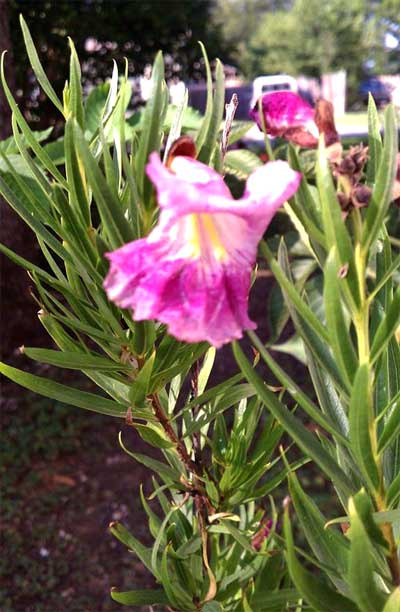
Answer: These are desert willows (Chilopsis linearis). They’re not even remotely related to willows, and they actually live along wet streambeds (albeit in arid areas), so they’re not truly “desert plants.” They’re close relatives of catalpas, and like their cousins, they do drop some leaves in mid-summer as a means of compensating for drought and heat. However, they’re well suited to your area once they get established. They grow to 12 to 16 feet tall and wide, and they have a very informal, almost random growth form. Severe winters can hurt them in the DFW area.
Question: I had landscaping done earlier this year, and sweet viburnums were added. What should I do to help this one? J., no city given.
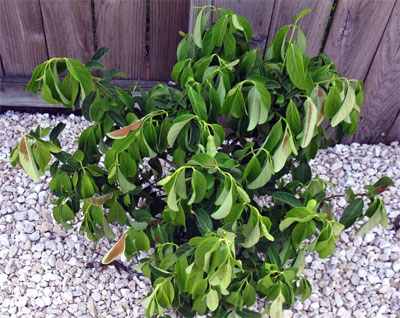
Answer: The only thing that would cause this to happen to a sweet viburnum is moisture stress. This plant has either gotten too dry (and may not come back), or it can’t handle the hot, reflective effects of the white stone mulch. White surfaces reflect light and heat to the backs of plants’ leaves, and that adds a great deal of extra stress to the plants. All viburnums need a great deal of shade – probably no direct sunlight after 9 or 9:30 on a summer morning.
Question: I am concerned that my holly ferns are dying from the virus I have read about online. Our nursery people just tell me that it’s natural dieback from dry weather. I trim off the affected fronds, but it seems to be spreading. Please advise. No name, no city given.
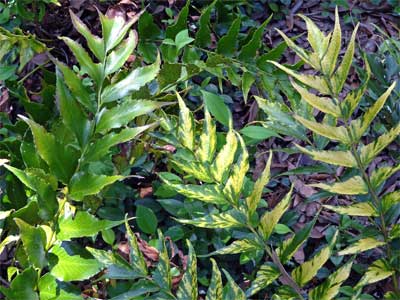
Answer: This is a new virus, as you have seen in the writings. Here is the best explanation of the disease and how to cope with it, although I found other LSU writings with specific photos that look just like yours. I’m sorry for the direction of this information.
Question: We did not expect our poolside palm to bloom, but this is what we saw this summer. Now the flower stalks are tan and spent. Is it OK to remove them? Was this an odd occurrence? T.H., Cedar Park
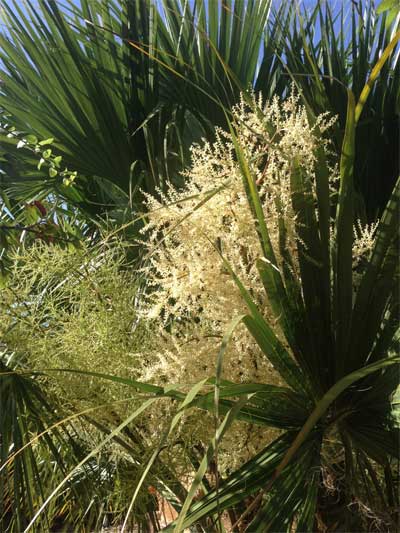
Answer: You are absolutely fine trimming off the old flower stalks. Obviously, your plant has become mature enough to be reproductive, so expect it to bloom in future summers (as long as it doesn’t suffer winter damage).
Question: I’ve been given the job of trimming the Burford holly hedge at our church. It’s about 20 years old, and I’m afraid it is getting too tall and too wide. Some of the stems are too large for my pruning tools. Do I dare use a chain saw to prune it? Am I worrying about something that isn’t that big a problem? J.N., Ponder.
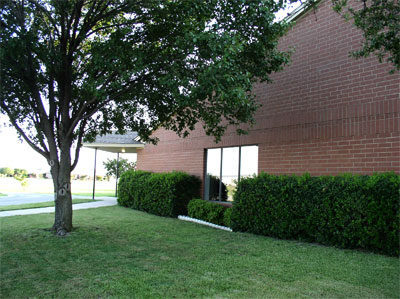
Answer: If you have stems that large, and because these plants are growing in a very formal square shape, they have probably been pruned back many times over those 20 years. If the church members want the square form, I would continue pruning at the very same size. To trim it as much as you’re describing, I fear that you would end up denuding the plants. They very likely wouldn’t have the energy to produce new growth yet again. Plus, they’d grow right back to this same size. I’m a big believer in choosing plants that grow to the proper mature size, then letting them grow more or less naturally – so as to avoid a lot of formal shearing. But when I tried to design a landscape that fit that description at my own church, the moment I stepped away from its maintenance, the new team of volunteers brought out the hedge trimmers and squared off every plant. To which I simply said, “Oh, well.”
Question: This Madame Galen trumpetvine was planted in 2010. I trim it each winter to keep it compact. I know it can become really invasive. It has never flowered. Why? J.J., Parker County.
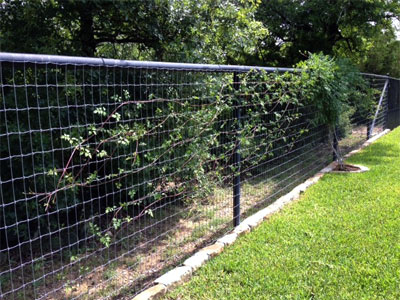
Answer: When you trim a trumpetcreeper back heavily, it will produce tons of new leaf and stem growth the following year, very much at the expense of flower production. Madame Galen is not especially invasive. If this were my vine, I would definitely let it sprawl down the fence a bit farther. I would prune it as little as possible. Also, the other photo you attached looks a lot shadier than this one. Madame Galen needs 8 or 10 hours of sunlight daily during the summer.
Question: What drought-tolerant and deer-resistant vine could we put up over the top of our subdivision’s new community mailbox? N., San Antonio.
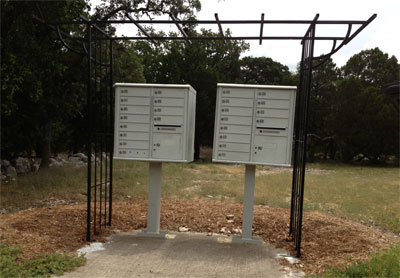
Answer: I’d suggest one of the climbing Earth-Kind roses such as Climbing Pinkie or Lady Banksia (not yet designated as Earth-Kind, but might as well be). The mailbox looks substantial enough to support Madame Galen trumpetcreeper, too, although Madame Galen is more robust and not evergreen. Of course, all of these will need some amount of irrigation, especially as they are getting established.
Question: What insect is boring into my wax myrtle’s trunks? L.T.L.C., no city given.
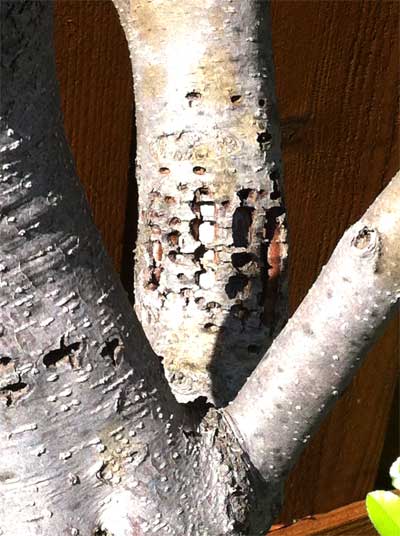
Answer: This is the work of sapsuckers or woodpeckers. They are not harmful in their own right, and they do not suggest the presence of any insect within the trunks of the plant. You could either apply a paper tree wrap around this area to discourage them, or you could apply Tree Tanglefoot. Birds hate the sticky material.
Question: I am attaching a photo of one of our two lacebark elms. They are both developing holes like this. What should I do? G.B., no city given.
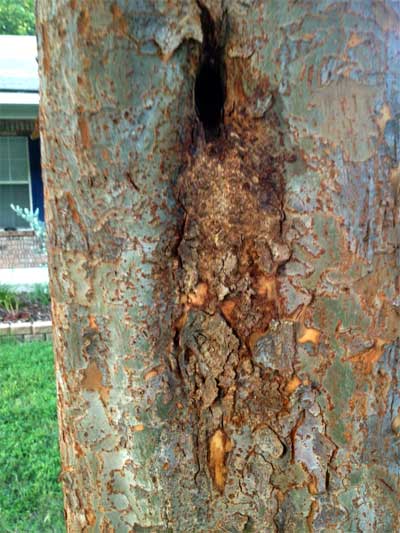
Answer: It’s difficult to tell from just one photo, but this looks like there has been decay at the top of this area. That could have spread from a small branch or twig that died and was not removed properly. If it appears to be serious, you probably should have a certified arborist look at the trees in person.

